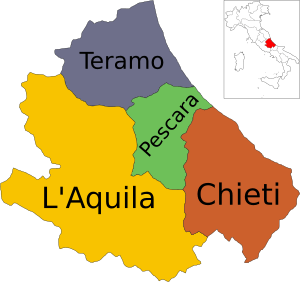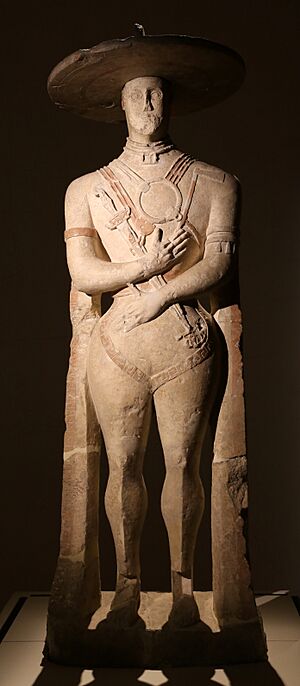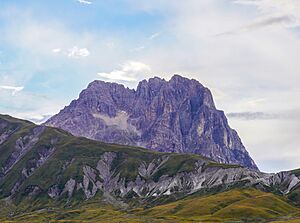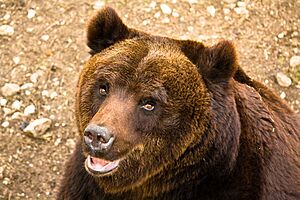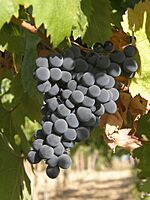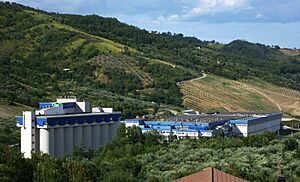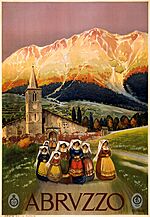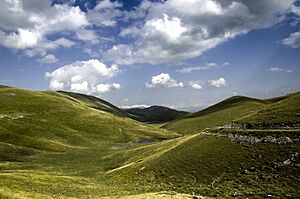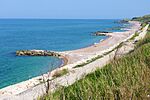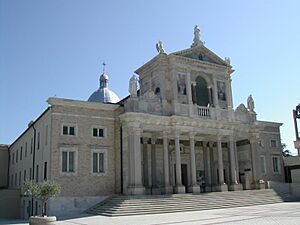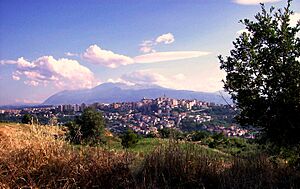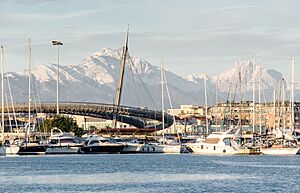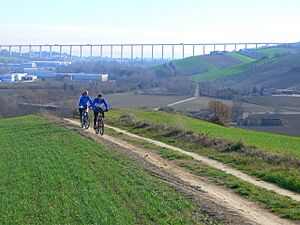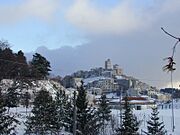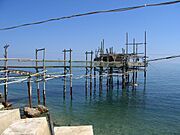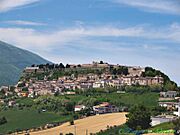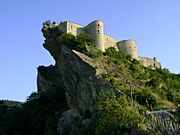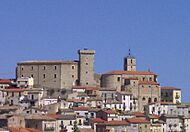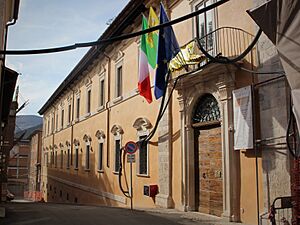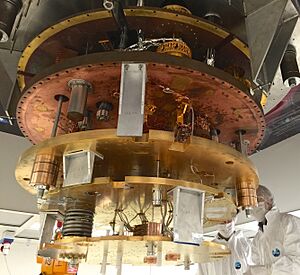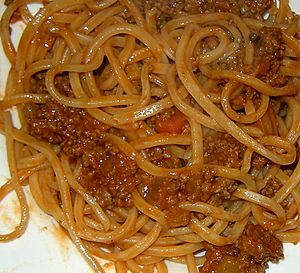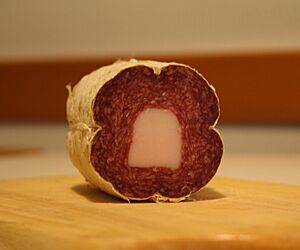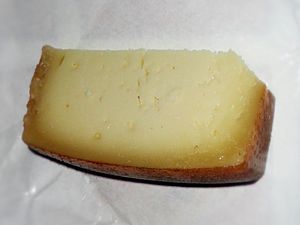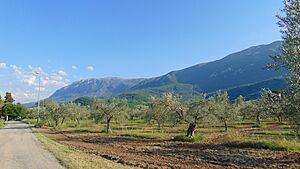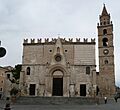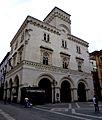Abruzzo facts for kids
Quick facts for kids
Abruzzo
Abbrùzzu / Abbrùzze (Neapolitan)
Abruzzi
|
|||
|---|---|---|---|
|
|||
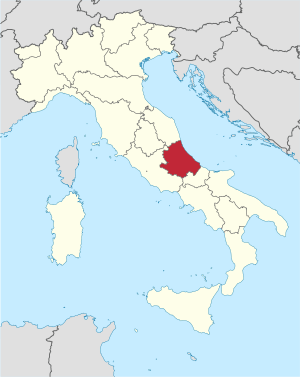 |
|||
| Country | |||
| Capital | L'Aquila | ||
| Largest city | Pescara | ||
| Area | |||
| • Total | 10,763 km2 (4,156 sq mi) | ||
| Highest elevation | 2,914 m (9,560 ft) | ||
| Population
(2020)
|
|||
| • Total | 1,305,770 | ||
| • Density | 121.320/km2 (314.218/sq mi) | ||
| Demonym(s) | Italian: Abruzzese | ||
| GDP | |||
| • Total | €32.889 billion (2021) | ||
| Time zone | UTC+1 (CET) | ||
| • Summer (DST) | UTC+2 (CEST) | ||
| ISO 3166 code | IT-65 | ||
| HDI (2021) | 0.892 very high · 13th of 21 |
||
| NUTS Region | ITF | ||
| Website | https://www.regione.abruzzo.it/ | ||
Abruzzo ( Abruzzese Neapolitan: Abbrùzze Abbrìzze or Abbrèzze Aquilano: Abbrùzzu), historically known as Abruzzi, is a region of Southern Italy with an area of 10,763 square km (4,156 sq mi) and a population of 1.3 million. It is divided into four provinces: L'Aquila, Teramo, Pescara, and Chieti. Its western border lies 80 km (50 mi) east of Rome. Abruzzo borders the region of Marche to the north, Lazio to the west and north-west, Molise to the south and the Adriatic Sea to the east. Geographically, Abruzzo is divided into a mountainous area in the west, which includes the highest massifs of the Apennines, such as the Gran Sasso d'Italia and the Maiella, and a coastal area in the east with beaches on the Adriatic Sea.
Abruzzo is considered a region of Southern Italy in terms of its culture, language, economy, and history, though in terms of physical geography it may also be considered part of Central Italy. The Italian Statistical Authority (ISTAT) also deems it to be part of Southern Italy, partly because of Abruzzo's historic association with the Kingdom of the Two Sicilies.
Almost half of the region's territory is protected through national parks and nature reserves, more than any administrative region on the continent, leading it to be dubbed "the greenest region in Europe." There are three national parks, one regional park, and 38 protected nature reserves. These ensure the survival of rare species, such as the golden eagle, the Abruzzo (or Abruzzese) chamois, the Apennine wolf and the Marsican brown bear. Abruzzo's parks and reserves host 75% of Europe's animal species. The region is also home to Calderone, one of Europe's southernmost glaciers.
Nineteenth-century Italian diplomat and journalist Primo Levi (1853–1917) chose the adjectives forte e gentile ("strong and kind") to capture what he saw as the character of the region and its people. "Forte e gentile" has since become the motto of the region.
Contents
Provinces and politics
Provinces
Abruzzo is divided into four administrative provinces:
| Province | Area (km2) | Population | Density (inh./km2) | Provincial Capital | Number of Communes |
|---|---|---|---|---|---|
| Chieti | 2,588 | 396,190 | 153.1 | Chieti | 104 |
| L'Aquila | 5,034 | 308,876 | 61.3 | L'Aquila | 108 |
| Pescara | 1,225 | 318,701 | 260.1 | Pescara | 46 |
| Teramo | 1,948 | 308,769 | 158.5 | Teramo | 47 |
Politics
The Politics of Abruzzo takes place in a framework of a presidential representative democracy, whereby the President of Regional Government is the head of government, and of a pluriform multi-party system. Executive power is exercised by the Regional Government. Legislative power is vested in both the government and the Regional Council.
The Regional Government (Giunta Regionale) is presided by the President of the Region (Presidente della Regione), who is elected for a five-year term, and is composed by the President and the Ministers (Assessori), who are currently 8, including a Vice President (Vicepresidente) and an undersecretary (Sottosegretario).
History
Prehistory
Paleolithic
Even if an earlier presence cannot be ruled out, findings related to archaic humans date from up to around 700,000 years ago (Acheulean Culture). Thousands of flint tools and weapons were collected on fluvial terraces (e.g. Madonna del Freddo at Chieti) and near former lakes (e.g. Valle Giumentina at Caramanico Terme and Valle Peligna at Popoli), which testify to different cultures from Homo erectus to neanderthalensis and sapiens. As in other sites, the one located at Popoli (Svolte di Popoli) also contained animal bones, which was in that case of hippopotamus. The most important evidence of Neanderthals was brought to light in caves at Calascio and dates back to the Middle Paleolithic.
Large evidence of Upper Paleolithic human populations was found in different places, like Fucino depression and Montebello di Bertona, which gave name to its peculiar stoneworking technique - Bertonian.
Neolithic
After the Mesolithic transition characterized by climate change and lack of food resources, agriculture was introduced by Neolithic farmers from the Middle East. A skeleton from Lama dei Peligni in the province of Chieti dates back to 6,540 BC under radiometric dating.
In Abruzzo and Marche, villages of the typical Ripoli culture, which originated in the 5-6th millennium BC, consisted of huts, and were generally located on fluvial terraces or hills overlooking rivers, in some cases defended by a moat, whereas caves were often used for rituals. They practiced agriculture, husbandry, hunting, fishing, and production of pottery, which was painted or decorated. Other older Neolithic cultures present in Abruzzo are called Impressed Ceramic and Catignano.
The Bronze and Iron Ages
The Bronze Age saw the spread of Apennine culture and Subapennine culture in central-southern Italy, including in Abruzzo. The former has been associated with pastoralism, whereas the latter also with agriculture. During the Late Bronze Age, Proto-Villanovan culture emerged also in Abruzzo. There are sites of Iron Age necropoli at Fiorano (Loreto Aprutino's frazione), Campovalano (Campli), Alfedena and Capestrano.
Italic peoples and Roman history
Emerged from the Iron Age and Orientalizing period, Abruzzo was inhabited by different peoples, among those defined by Ancient Roman tradition as Sabelli: Oscan-speaking Pentri, Carricini and Frentani, and, more generically, Osco-Umbrian Aequi, Praetutii, Vestini, Marrucini, Marsi and Peligni.
Considered extremely strong by Ancient writers, they fought against Roman ambitions in the Samnite Wars (from 343 to 290 BC), but some accepted the alliance with the Romans, whereas others surrendered after Samnite Wars. Following the progressive Romanization, they supported the Romans and contributed to many victories in the 3rd and 2nd centuries BC. They fought again with Rome during the Social War (91–87 BC) to gain political rights and created the ephimeral state called Italia with Corfinio as the capital. After the Social War, they obtained Roman citizenship and in the Imperial period were favored by many economic activities, such as trade and pastoralism. On the basis of a division by Augustus, the territory of what is now Abruzzo was part of "Regio V Picenum" and especially "Regio IV Sabina et Samnium". Much later, the region corresponded to Valeria province according to Diocletian decisions, and was among the first to see the arrival of Christianity.
With their archeological sites, many cities in Abruzzo date back to ancient times. Corfinio was known as Corfinium when it was the chief city of the Paeligni, and became the capital of "Italia" against the Romans during the Social War. Today's Chieti was inhabited since the Chalcolithic and became an important center of Marrucini (Teate Marrucinorum). Atri was known as Hatria and Teramo was known variously in ancient times as Interamnia and Teramne. Pinna (today Penne), Anxanum (Lanciano), Hortona (Ortona), Histonium (Vasto), Sulmona and Marruvium (San Benedetto dei Marsi) are among the settlements that are still inhabited, whereas others are no longer so, such as Cluviae near Casoli.
Middle Ages
The region was known as Aprutium in the Middle Ages and, according to a hypothesis, it is a combination of Praetutium, or rather of the name of the people, Praetutii, applied to their chief city, Interamnia, the old Teramo.
Lombards and Franks
After the fall of the Western Roman Empire, the destructions caused by the Gothic War betwneen the Byzantine Empire and the Ostrogothic Kingdom, and the arrival of the Germanic Lombards, there were furious devastations and lootings of monasteries and towns in the region. Around 572, the Lombards divided Abruzzo into the Duchy of Benevento and of Spoleto, with Faroald I of Spoleto becoming the first Duke of Spoleto. His successor, Ariulf of Spoleto, annexed other territories: the former territories controlled by Aequi, Marsi, Peligni and Vestini. In the 8th century, Transamund II of Spoleto rebelled against Liutprand, King of the Lombards, but was able to recover his duchy and also to include other remaining territories of former Valeria province.
After the beginning of domination by the Franks, in 801, Teate (today's Chieti) also passed from the Lombardic Duchy of Benevento to the Frankish Duchy of Spoleto. In 843, some territories were separated from the duchy (all the region together with the district of Rieti and except that of Teramo according to Liber provincialis), with Celano as capital. So counts of Marsi from different lineages ruled "Marsia" from 843 to 926. In 871, Louis II of Italy founded, as the Carolingian Emperor, a monastery, which would become very powerful in the history of Abruzzo (Abbey of San Clemente a Casauria). With the rule of Hugh of Italy from 926, the territories were divided: Penne and Teate to Atto I, and today's province of L'Aquila to Berardo.
Kingdom of Sicily
After two attempted conquests from two Norman princes of Capua in Abruzzo, two other Normans, Robert Guiscard and Robert I of Loritello, conquered Teate, Valva and Penne. Later, all Abruzzo was definitively conquered by Norman Roger II of Sicily, and in 1156 his son William I of Sicily had these victories officially recognized by Pope Adrian IV (Norman conquest of southern Italy).
As part of the Kingdom of Sicily, Abruzzo was involved in the conflicts following the death of William II of Sicily in 1189, and the territories sided with Constance, Queen of Sicily and Henry VI, Holy Roman Emperor, but after the death of the former in 1198, they were invaded by Otto IV, Holy Roman Emperor. They were also involved in the conflicts between Frederick II (son of Queen Costance) and Pope Gregory IX, including the War of the Keys. The administrative region of Abruzzo was formed in the 1230s, when Frederick II divided his realms into justiciarates, with Abruzzo forming one of them.
The newly founded L'Aquila was destroyed by Manfred, King of Sicily (son of Frederick II) in 1259, and supported in the Battle of Tagliacozzo (1268) the defeat of his nephew Conradin against Charles I of Anjou, the new king of Sicily. Since the last half of the 13th century, L'Aquila took a central role in the region. Abruzzo was divided into Abruzzo Citra (nearer Abruzzo) and Abruzzo Ultra (further Abruzzo) by Charles I of Anjou in the 1270s.
Kingdom of Naples
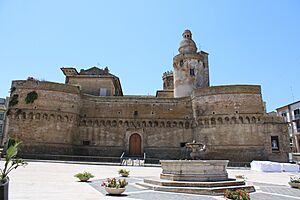
After the rebellion called Sicilian Vespers and the subsequent war, in 1302 the Peace of Caltabellotta divided the former Kingdom of Sicily as follows: Sicily to the Crown of Aragon and the Southern Italian Peninsula (including Abruzzo) still to the Capetian House of Anjou.
The region was profoundly affected during the wars that followed a conspiracy which resulted in the assassination of Andrew, Duke of Calabria, the husband of Queen Joanna I of Naples. Different towns (L'Aquila, Penne, Chieti, Lanciano, Ortona) sided at first with the brother of the victim, Louis I of Hungary. In 1443, Alfonso V of Aragon, King of Sicily, conquered the Kingdom of Naples. In the same years, Abruzzo saw many battles, including the ones associated with the War of L'Aquila. Under the Aragonese rulers, L'Aquila started to become a military center, giving up its political and economic importance to Chieti. This period was characterized by economic decline and the spread of brigandage, but coastal centers were favored by trade with the Republic of Venice's overseas territories.
Shortly after the Italian War of 1494–1495 carried out by Charles VIII of France, the Kingdom of Naples returned to Ferdinand II of Aragon. In this and in the following conflict between the Kingdom of France and the Kingdom of Spain over the Kingdom of Naples, Abruzzo sided with France, but Spain won in 1503 and started to dominate the Kingdom of Naples with its viceroys. In Abruzzo, the aristocracy vainly tried to regain more control when there was a rebellion in the Kingdom of Naples led by a fisherman named Masaniello in 1647.
At the beginning of the 18th century, the region was affected by destructive earthquakes, which also devastated L'Aquila (1703 Apennine earthquakes) and Sulmona (1706 Abruzzo earthquake), and the War of the Spanish Succession, with the Austrian siege at Pescara in 1707. In 1734, Charles III of the House of Bourbon, King of Spain, ended the short Hasburg Austrian domination, which contributed to large land concentrations in Abruzzo.
From French Revolutionary wars to World War II
In accordance with a general diffidence against the Enlightenment ideas, the Abruzzo population of different social classes rebelled in an improvised way against French invasion in 1798 and 1799, before the proclamation of the ephemeral Parthenopean Republic, to which they continued to be hostile (Sanfedismo). In 1806, Abruzzo Ultra was divided into two (in the Kingdom of Naples (Napoleonic)), as Abruzzo Ultra I and Abruzzo Ultra II (being divided at the Gran Sasso d'Italia); the same Citra/Ultra I/Ultra II scheme was used for Calabria. After the rule of Napoleon, who created a client kingdom, and the return of the Bourbons granted by the Congress of Vienna, Abruzzo was plagued by decline and brigandage. The House of Bourbon-Two Sicilies established the Kingdom of the Two Sicilies in 1816, and ruled until Italian unification (also known as the Risorgimento).
Risorgimento
Many rebelled again in 1821, 1841 and 1848 (Revolutions of 1848), but the ideas of insurgents were different (liberal, Jacobin and reactionary). During the unification of Italy, in 1860, Abruzzo became part of the Kingdom of Sardinia and, in 1861, the Kingdom of Italy. Supporters of the Bourbons fought against volunteers of Garibaldi, whereas others later banded with simple criminals to participate for political reasons in brigandage, which was eradicated years later, but many accepted the new order without enthusiasm or opposition. Since 1870, due to its economic conditions, Abruzzo saw massive emigration to other regions and countries, which contributed to Italian diaspora.
Fascism and World War II
During the Italian fascism period, Pescara became an important center for its homonymous port, tourism and trade. With the Second World War, Abruzzo was on the Gustav Line, part of the German Winter Line. One of the most brutal battles was the Battle of Ortona. Abruzzo was the location of two prisoners of war camps, Campo 21 in Chieti, and Campo 78 in Sulmona. The Sulmona camp also served as a POW camp in World War I; much of the facility is still intact and attracts tourists interested in military history.
Italian Republic
Despite the high level of destructions and victims caused by the Second World War, there was remarkable development in the second half of the 20th century, which particularly favored Fucino and Adriatic coastal areas.
In the 1948 Italian Constitution, these were unified with Molise into the Abruzzi e Molise region, though in the first draft Abruzzo and Molise were separate, and in 1963 Abruzzi e Molise was separated into the two regions of Abruzzo and Molise. Abruzzo Citeriore is now the province of Chieti. The province of Teramo and province of Pescara now comprise what was Abruzzo Ulteriore I. Abruzzo Ulteriore II is now the province of L'Aquila.
Geography
Geographically, Abruzzo is nearly at the center of Italian peninsula, stretching from the heart of the Apennines to the Adriatic Sea, and includes mainly mountainous and wild land. The mountainous land is occupied by a vast plateau, including Gran Sasso, at 2,912 metres (9,554 ft) the highest peak of the Apennines, and Mount Majella at 2,793 metres (9,163 ft). The Adriatic coastline is characterized by long sandy beaches to the North and pebbly beaches to the South. Abruzzo is well known for its landscapes and natural environment, parks and nature reserves, characteristic hillside areas rich in vineyards and olive groves. Many beaches have been awarded the Blue Flag beach status.
Climate
In Abruzzo there are two climatic zones. The coastal strip and sub-Apennine hills have a climate markedly different from that of the mountainous interior. Coastal areas have a Mediterranean climate with hot dry summers and mild winters. Inland hilly areas have a sublittoral climate with temperatures decreasing progressively with increasing altitude. Precipitation is also strongly affected by the presence of the Apennines mountain range. Rainfall is abundant on slopes oriented to the west, and lower in east and east-facing slopes. The Adriatic coast is shielded from rainfall by the barrier effect created by the Apennines. The minimum annual rainfall is found in some inland valleys, sheltered by mountain ranges, such as Peligna or Tirino (Ofena, Capestrano), where as little as 500 millimetres (19.7 inches) were recorded. Rainfall along the coast almost always never falls below 600 millimetres (23.6 inches). Pescara has relatively less rainfall (about 700 millimetres (27.6 inches)) than Chieti (about 1,000 millimetres (39.4 inches)). The highest rainfall occurs in upland areas on the border with Lazio; they are especially vulnerable to Atlantic disturbances. Around 1,500 to 2,000 millimetres (59 to 79 inches) of precipitation is typical.
Flora and fauna
The flora of Abruzzo is typically Mediterranean. Along the coastal belt Mediterranean shrubland Is the dominant natural vegetation, with species like myrtle, heather and mastic. Inland we find olive, pine, willow, oak, poplar, alder, arbutus, broom, acacia, capers, rosemary, hawthorn, licorice and almond trees, interspersed with oak trees. At elevations between 600 and 1,000 metres (2,000 and 3,300 ft) there is sub-montane vegetation, with mixed woodlands of oak and turkey oak, maple and hornbeam; shrubs include dog rose and red juniper. Elevations between 1,000 and 1,900 metres (3,300 and 6,200 ft) are dominated by beech. In the Apennine Mountains at elevations above 2,000 metres (6,600 ft) species include alpine orchid, mountain juniper, silver fir, black cranberry and the Abruzzo edelweiss.
The fauna of Abruzzo is very diverse, including the region's symbol, the Abruzzo chamois (Rupicapra pyrenaica ornata), which has recovered from near-extinction. Common species include Marsican brown bear, Italian wolf, deer, lynx, roe deer, snow vole, fox, porcupine, wild cat, wild boar, badger, otter, and viper.
The natural parks of the region are the Abruzzo National Park, the Gran Sasso and Monti della Laga National Park, the Maiella National Park and the Sirente-Velino Regional Park, as well as many other natural reserves and protected areas.
In 2017, the ancient beech forests of the Abruzzo Lazio and Molise National Park of Europe were recognized as a World Heritage Site by UNESCO, with the region thus gaining its first prestigious site.
Economy
Until a few decades ago, Abruzzo was a backward region of Southern Italy. Since the 1950s, Abruzzo has showed steady economic growth. In 1951, per capita income or GDP was 53% of that of wealthier Northern Italy. The gap has since narrowed, being 65% in 1971 and 76% by 1994. The region reached the highest per capita GDP of Southern Italy through the highest growth rate of every other region of Italy. The unemployment rate stood at 9.3% in 2020.
Abruzzo is the 16th most productive region in the country, and is the 13th for GRP per capita among Italian regions.
As of 2003, Abruzzo's per capita GDP was €19,506 or 84% of the national average of €23,181, compared to the average value for Southern Italy of €15,808. In 2006, the region's average GDP per capita was approximately 20,100 EUR. The construction of motorways from Rome to Teramo (A24) and Rome to Pescara (A25), which provided better access to the region, is credited as a driver of public and private investments.
The 2009 L'Aquila earthquake led to a sharp economic slowdown. However, according to statistics at the end of 2010, some signals of recovery were noted. Regional economic growth was recorded as 1.47%, which actually placed Abruzzo fourth among Italy's regions after Lazio, Lombardy and Calabria. In 2011 Abruzzo's economic growth was +2.3%, the highest percentage among the regions of Southern Italy.
Industry
From the early 1950s to the mid-1990s Abruzzo's industrial sector expanded rapidly, especially in mechanical engineering, transportation equipment and telecommunications. The structure of production in the region reflects the transformation of the economy from agriculture to industry and services. The industrial sector relies on few large enterprises and the predominance of small and medium enterprises. In the applied research field, there are major institutes and enterprises involved in the fields of pharmaceutics, biomedicine, electronics, aerospace and nuclear physics. The industrial infrastructure is dispersed throughout the region in industrial zones. The most important of these are: Val Pescara, Val di Sangro, Val Trigno, Val Vibrata and Conca del Fucino.
The province of Teramo is one of the most industrialized areas of Italy and of the region, with numerous small and medium-sized companies, then follows the province of Chieti and that of Pescara, which is also supported by tourism; the Val Vibrata (province of Teramo), on the border with the Marche region, is home to a myriad of small and medium-sized enterprises, especially in the textile and footwear sectors. The Val di Sangro (province of Chieti), on the other hand, is home to important multinationals and a factory belonging to the Fiat (Sevel) group. The area of Valle Peligna (province of L'Aquila) is also home to industries (the famous one of Sulmona sugared almonds), while other areas such as Pescara and Theatine are home to numerous industries, including multinationals (for example De Cecco, Procter & Gamble, Monti & Ambrosini Editori, Brioni, Ennedue and Miss Sixty, mostly concentrated in the industrial district of Val Pescara in the province of Chieti).
Agriculture
Agriculture, based on small holdings, has modernised and produces high-quality products. The mostly small-scale producers are active in wine, cereals, sugar beet, potatoes, olives, vegetables, fruit and dairy products. Traditional products are saffron and liquorice. By the late 20th and early 21st centuries, Montepulciano d'Abruzzo, the region's most famous wine, had become one of the most widely exported DOC-classed wines in Italy.
As for the figures, the region produces about 850,000 quintals of fruit, 5 million quintals of vegetables, 1,600,000 quintals of potatoes, 5,000,000 quintals of grapes produced, both for table and for the production of wine; the latter is estimated at between 3 and 4 million hectoliters with the production of wines such as Montepulciano d'Abruzzo in the red and cerasuolo (rosé) varieties, Trebbiano d'Abruzzo, Pecorino and the Chardonnay; oil production, on the other hand, stands at 1,350,000 quintals of olives and 240,000 quintals of oil (Aprutino Pescarese, Pretuziano delle Colline Teramane and Colline Teatine), figures that put Abruzzo in sixth place among the Italian regions; as regards cereals, the durum wheat with over 1.5 million quintals constitutes the main cereal, followed by soft wheat (one million quintals), then barley (0.5 million quintals ); other crops are also grown such as beetroot (2,500,000 quintals), and tobacco (45,000 quintals).
Tourism
Tourism is an important economic sector; in the past decade, tourism has increased, mainly centered around its national parks and natural reserves, ski and beach resorts, in particular along the Trabocchi Coast. Abruzzo's castles and medieval towns, especially in the area of L'Aquila, have led to the creation of the nickname of "Abruzzoshire", along Tuscany's "Chiantishire". In spite of this, Abruzzo is still "off the beaten path" for most visitors to Italy.
Very popular with visitors from all over Italy and Europe the natural parks of the region such as the Abruzzo, Lazio and Molise National Park, the Gran Sasso e Monti della Laga National Park, the Maiella National Park and the Sirente-Velino Regional Park which every year attract thousands of visitors thanks to their nature unspoiled and rare wild fauna and flora species such as Abruzzo chamois moreover the region can boast many reserves, protected natural areas and lakes (Campotosto Lake and Lago di Scanno).
In the inland mountain areas there are the ski resorts of Scanno, Ovindoli, Pescasseroli, Tagliacozzo, Roccaraso, Campo Imperatore, Campo Felice, Rivisondoli, Pescocostanzo, Prati di Tivo, San Giacomo (Valle Castellana), Passolanciano-Majelletta, Prato Selva, Campo Rotondo, Campo di Giove, Passo San Leonardo, Passo Godi, Pizzoferrato, and Gamberale, where winter tourism is highly developed and then you can play sports such as alpine skiing, snowboarding, ski mountaineering, ski touring, cross-country skiing and dog sledding.
Also of considerable importance is the summer coastal and seaside tourism, which sees the presence of numerous tourist bathing establishments equipped in various centers of the coast such as Pescara, Montesilvano, Pineto, Roseto degli Abruzzi, Giulianova, Alba Adriatica, Tortoreto, Ortona, Vasto, Martinsicuro, Silvi Marina and the Trabocchi Coast.
Finally, tourism for historical and cultural purposes is also important, concentrated above all in the cities of Chieti, Teramo, Vasto, Giulianova, Sulmona, and above all L'Aquila which can boast many monuments, museums, castles and churches (St. Gabriel's shrine and Santa Maria di Collemaggio) of national importance; also Pescara despite being a modern city, boasts monuments, churches and museums of historical importance such as the Birthplace of Gabriele D'Annunzio Museum. In the inland mountain areas there are ancient villages, castles, hermitages, sanctuaries abbeys, and ancient churches.
Abruzzo has many small and picturesque villages, 26 of them have been selected by I Borghi più belli d'Italia (English: The most beautiful Villages of Italy), a non-profit private association of small Italian towns of strong historical and artistic interest, that was founded on the initiative of the Tourism Council of the National Association of Italian Municipalities.
Demographics
| Historical population | ||
|---|---|---|
| Year | Pop. | ±% |
| 1861 | 858,000 | — |
| 1871 | 906,000 | +5.6% |
| 1881 | 946,000 | +4.4% |
| 1901 | 1,070,000 | +13.1% |
| 1911 | 1,116,000 | +4.3% |
| 1921 | 1,131,000 | +1.3% |
| 1931 | 1,168,000 | +3.3% |
| 1936 | 1,202,000 | +2.9% |
| 1951 | 1,277,207 | +6.3% |
| 1961 | 1,206,266 | −5.6% |
| 1971 | 1,166,694 | −3.3% |
| 1981 | 1,217,791 | +4.4% |
| 1991 | 1,249,054 | +2.6% |
| 2001 | 1,262,392 | +1.1% |
| 2011 | 1,307,309 | +3.6% |
| 2021 | 1,275,950 | −2.4% |
| Source: ISTAT | ||
Although the population density of Abruzzo has increased over recent decades, it is still well below the Italian national average: in 2008, 123.4 inhabitants per km2, compared to 198.8. In the provinces, the density varies: as of 2008[update] Pescara is the most densely populated with 260.1 inhabitants per km2, whereas L'Aquila is the least densely populated with 61.3 inhabitants per km2, although it has the largest area. After decades of emigration from the region, the main feature of the 1980s is immigration from third world countries. The population increase is due to the positive net migration. Since 1991 more deaths than births were registered in Abruzzo (except for 1999, when their numbers were equal). In 2008, the Italian national institute of statistics ISTAT estimated that 59,749 foreign-born immigrants live in Abruzzo, equal to 4.5% of the total regional population.
The most serious demographic imbalance is between the mountainous areas of the interior and the coastal strip. The largest province, L'Aquila, is situated entirely in the interior and has the lowest population density. The movement of the population of Abruzzo from the mountains to the sea has led to the almost complete urbanization of the entire coastal strip especially in the province of Teramo and Chieti. The effects on the interior have been impoverishment and demographic aging, reflected by an activity rate in the province of L'Aquila which is the lowest among the provinces in Abruzzo – accompanied by geological degradation as a result of the absence of conservation measures. In the coastal strip, however, there is such a jumble of accommodations and activities that the environment has been negatively affected. The policy of providing incentives for development has resulted in the setting-up of industrial zones, some of which (Vasto, Avezzano, Carsoli, Gissi, Val Vibrata, Val di Sangro) have made genuine progress, while others (Val Pescara, L'Aquila) have run into trouble after their initial success. The zones of Sulmona and Guardiagrele have turned out to be more or less failures. Outside these zones, the main activities are agriculture and tourism. In 2016 the Huffington Post placed Abruzzo in fifth position among the twelve best regions in the world for quality of life.
Main settlements
L'Aquila is both the capital city of the Abruzzo region and of the Province of L'Aquila and second largest city (pop. 73,000). L'Aquila was hit by an earthquake on 6 April 2009, which destroyed much of the city centre. The other provincial capitals are Pescara, which is Abruzzo's largest city and major port (pop. 123,000); Teramo (pop. 55,000) and Chieti (pop. 55,000). Other large municipalities in Abruzzo include the industrial and high tech center Avezzano (pop. 41,000), as well as three important industrial and touristic centers such as Vasto (pop. 40,636), Lanciano (pop. 36,000), and Sulmona (pop. 25,000).
Transport
Airports
- Abruzzo International Airport is the only international airport in the region. Open to civilian traffic since 1996, the number of passengers has increased over the years because of low-cost air carriers' use of the facility. Today, the airport has a catchment area of over 500,000 passengers annually.
- L'Aquila-Preturo Airport is located near L'Aquila, but remains underused.
Ports
There are four main ports in Abruzzo: Pescara, Ortona, Vasto and Giulianova.
Over the years the Port of Pescara has become one of the most important tourist ports of Italy and the Adriatic Sea. Heavily damaged in World War II, it underwent major renovations for some sixty years. It now consists of a modern marina with advanced moorings and shipbuilding facilities. It has been awarded the European Union's blue flag for its services. The port of Pescara has lost passenger traffic because of its shallowness and silting, but its fishery and aquaculture activities are thriving.
Railways
There is a significant disparity between the railways of the Abruzzo coast and the inland areas, which badly need modernization to improve the service, in particular, the Rome-Pescara line.
Existing railway lines:
- Adriatic railway runs through the whole of Italy from north to south, along the Adriatic Sea.
- Rome – Sulmona – Pescara
- Sulmona – Carpinone
- Sulmona–Terni railway
- Avezzano railroad – Roccasecca
- Giulianova – Teramo
- Sangritana (Lanciano – Castel di Sangro)
Highways
There are three highways that serve the region:
- A24 (Rome – L'Aquila – Teramo) was built in the 1970s and connects Rome with the Adriatic coast in less than two hour-drive. The Gran Sasso tunnel, the longest road tunnel entirely on Italian territory, was opened in 1984.
- A25 (Torano – Avezzano – Pescara) connects Rome with Pescara. The road branches off A24 in Torano, spans across the Fucino basin, crosses the Apennines, and merges with A14 near Pescara.
- A14 Bologna – Taranto known as the "Adriatica", includes 743 km (461.68 mi) of dual-carriage motorway between Bologna and Taranto.
Culture
The museum Museo Archeologico Nazionale d'Abruzzo in Chieti houses the famed statue Warrior of Capestrano which was found in a necropolis of the 6th century B.C. Across the region, among the prominent cultural and historical buildings are: Teramo Cathedral, its archeological museum and the Roman theater, the Castello della Monica, the Collurania-Teramo Observatory, the famous L'Aquila Basilica of Santa Maria di Collemaggio (which holds the remains of Pope Celestine V), the Museo Nazionale d'Abruzzo, Santa Maria del Suffragio, the Forte Spagnolo, the Fountain of 99 Spouts, Gabriele D'Annunzio's house in Pescara, Campli's Scala Sancta and its church, the church of Santissima Annunziata in Sulmona, the cathedrals of Chieti, Lanciano, Guardiagrele, Atri and Pescara along with the castles of Ortona, Celano and Ortucchio.
Every year on 28–29 August, L'Aquila's Santa Maria di Collemaggio commemorates the Perdonanza Celestiniana, the indulgence issued by Pope Celestine V to anyone who, "truly repentant and confessed" would visit that Church from the Vespers of the vigil to the vespers of 29 August. Sulmona's Holy Week is commemorated with traditional celebrations and rituals, such as "La Madonna che scappa in piazza", when a large statue of the Mary, carried by a group of local fraternities, is carried across the square in procession. Cocullo, in the province of L'Aquila, holds the annual "Festa dei serpari" (festival of snake handlers) in which a statue of St. Dominic, covered with live snakes, is carried in a procession through the town; it attracts thousands of Italian and foreign visitors. In many Abruzzo villages, Anthony the Great's feast is celebrated in January with massive and scenic bonfires.
In the past, the region of Abruzzo was well known for the transumanza, the seasonal movement of sheep floks: these used to travel mostly southbound towards the region of Puglia during the cold winter months. The Feast of St. Biagio, protector of wool dealers is celebrated across the region. On the third of February in Taranta Peligna every year since the sixteenth century an evocative ritual is held: panicelle, or small loaves made of flour and water, in the shape of a blessing hand, are distributed among the faithful.
Historical figures from the region include: the Roman orator Asinius Pollio; Latin poets Sallust and Ovid, who were born in L'Aquila and Sulmona respectively, Gaius Cassius Longinus, Roman senator and leading instigator of the plot to kill Julius Caesar. Pontius Pilate is said to have been native to the region. Abruzzo's religious personalities include Saint Berardo; John of Capistrano; Thomas of Celano, author of three hagiographies of Saint Francis of Assisi; and Alessandro Valignano, who introduced Catholicism to the Far East and Japan. The Polish Pope John Paul II loved the mountains of Abruzzo, where he would retire often and pray in the church of San Pietro della Ienca. Local personalities in the humanities include: poet Ignazio Silone, movie director Ennio Flaiano who co-wrote La dolce vita, philosopher Benedetto Croce, poet Gabriele D'Annunzio, composer Paolo Tosti, sculptor Venanzo Crocetti and artist LorenzoArs.
American artists and celebrities such as: Dean Martin, Perry Como, Henry Mancini, Nancy Pelosi, Rocky Marciano, Rocky Mattioli, Bruno Sammartino, Mario Batali, John and Dan Fante, Tommy Lasorda, Dan Marino, Mario Lanza, Garry Marshall, Penny Marshall, Ariana Grande, and Al Martino trace part of their family roots to Abruzzo.
Some international movies shot in Abruzzo include The American, Jean-Jacques Annaud's The Name of the Rose, Fellini's La Strada and I Vitelloni, Schwarzenegger's Red Sonja, Ladyhawke, King David, Francesco, Keoma, The Barbarians, The Fox and the Child and Krull.
Medieval and Renaissance hill towns
Before the 2009 earthquake, Abruzzo was the region with the highest number of castles and hill towns in Italy. It still holds many of Italy's best-preserved medieval and Renaissance hill towns, twenty-three of which are among I Borghi più belli d'Italia. This listing recognises their scenic beauty, arts and culture, their historical importance and quality of life.
The abrupt decline of Abruzzo's agricultural economy in the early to mid-20th-century spared some of the region's historic hill towns from modern development. Many lie entirely within regional and national parks. Among the most well preserved are Castel del Monte and Santo Stefano di Sessanio, within the Gran Sasso National Park on the edge of the high plain of Campo Imperatore and nestled beneath the Apennines' highest peaks. Both hill towns, which were ruled by the Medicis for over a century-and-a-half, see relatively little tourism. Between the two towns sits Rocca Calascio, the ruin of an ancient fortress popular with filmmakers. Both Monteferrante and Roccascalegna are two of the most representative Abruzzo villages in the province of Chieti. Within the Gran Sasso National Park is also found Castelli, an ancient pottery center whose artisans produced ceramics for most of the royal houses of Europe.
Civitella del Tronto played a crucial role in the history of the unification of Italy. The fortress of Civitella is the most visited monument in the Abruzzo region today. Other medieval hill towns located within Abruzzo's park system are Pacentro in the Maiella National Park and Pescasseroli in the Abruzzo National Park. Pacentro, which features a 14th-century castle with two intact towers, has been little touched by modernisation. The Shrine of Gabriel of Our Lady of Sorrows, in the province of Teramo, which attracts some two million visitors per year, is one of the 15 most-visited sanctuaries in the world. Capestrano, a small town in the province of L'Aquila, is the hometown of Saint John of Capistrano, Franciscan friar and Catholic priest, as well as the namesake of the Franciscan missions San Juan Capistrano in Southern California, the mission Mission San Juan Capistrano in Texas and the city of San Juan Capistrano in Orange County, California. Giulianova is a notable example of a Renaissance "ideal city".
The proximity to Rome, the protected areas and scenic landscapes making the region one of the greenest in Europe, the presence of quaint villages, its rich and varied culinary traditions are important tourist attractions. In 2010, visitors included 6,381,067 Italians and 925,884 foreign tourists.
In 2015, the American organization Live and Invest Overseas included Abruzzo on its list of World's Top 21 Overseas Retirement Havens. The study was based on such factors as climate, infrastructure, health care, safety, taxes, cost of living and more. In 2017 the Chamber of Commerce of Pescara presented Abruzzo region to the Annual conference of Live and Invest Overseas in the U.S. city of Orlando, Florida. One year later, in October 2018, Live and Invest Overseas held its first conference in Abruzzo.
Universities
There are three universities in the Abruzzo region:
- University of L'Aquila
- D'Annunzio University of Chieti–Pescara
- University of Teramo
Harvard University bases an intensive summer Italian language and culture program in Vasto, a resort town on Abruzzo's southern coast.
Science
Between the province of Teramo and L'Aquila, under the Gran Sasso Tunnel, is the Laboratori Nazionali del Gran Sasso (LNGS) of the INFN, one of the three underground astroparticle laboratories in Europe.
The Istituto Zooprofilattico Sperimentale dell'Abruzzo e del Molise "Giuseppe Caporale", which conducts research in veterinary and environmental public health, is located in Teramo.
The Gran Sasso Science Institute, located in L'Aquila, is an advanced research institute which offers doctorates in astroparticle physics, computer science, and mathematics as well as urban studies and regional science, and which also conducts scientific research.
Sports
Interamnia World Cup, the largest international youth handball competition worldwide, takes place yearly in Teramo.
There are several football clubs in Abruzzo. Delfino Pescara 1936 is a Serie C club; based in Pescara, its home stadium is Stadio Adriatico – Giovanni Cornacchia.
Dialects
The regional dialects of Abruzzo include Teramano, Abruzzese Orientale Adriatico and Abruzzese Occidentale. The first two forms are a dialect of the Southern Italian language also known simply as Neapolitan since the region has been part of the Kingdom of Naples and the Kingdom of the Two Sicilies, while Aquilano is related to the Central Italian dialects including Romanesco. The dialects spoken in the Abruzzo region can be divided into three main groups:
- Sabine dialect, in the province of L'Aquila, a central Italian dialect
- Abruzzo Adriatic dialect, in the province of Teramo, Pescara and Chieti, that is virtually abandoned in the province of Ascoli Piceno, a southern Italian dialect
- Abruzzo western dialect, in the province of L'Aquila, a southern Italian dialect
Cuisine
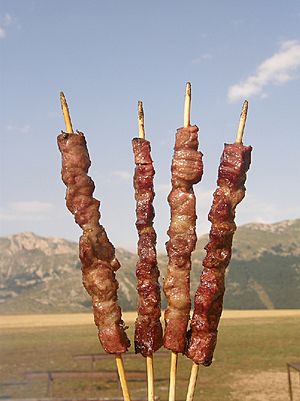
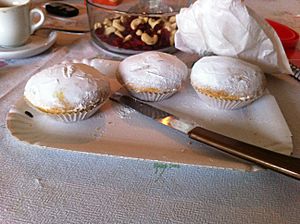
Abruzzo's cuisine is renowned for its variety and richness. Both the agricultural and coastal areas of Abruzzo have contributed to its cuisine. Due to the mountains, much of Abruzzo was relatively isolated until the 20th century. This has contributed to preservIng local culinary traditions.
Ingredients
In terms of common ingredients, cuisine in Abruzzo often includes:
- Lamb and mutton, primarily in the mountains. Sheep's milk (or ricotta) is an important source of Abruzzese cheese, and lamb intestines are used as sausage casing or for stuffed meat rolls. Mountain goat meat is also common in Abruzzo.
- Truffles and mushrooms, particularly wild mushrooms from the forests and hills
- Garlic, especially red garlic
- Rosemary
- Hot chili pepper or peperoncini, regionally known as diavolilli or diavoletti, is common in Abruzzese cuisine and often used to add spice to dishes. Abruzzo residents are well known for frequently adding peperoncini, or hot peppers, to their meals.
- Vegetables such as lentils, grasspeas and other legumes, artichoke, eggplant, and cauliflower
Starter and main dishes
- Spaghetti alla chitarra which is made by pressing or cutting pasta through a chitarra, an implement to form long thin noodles similar to spaghetti. The pasta is served with a tomato-based sauce, often flavored with peppers, pork, goose, or lamb. This dish is complemented by regional side dishes, such as the bean and noodle soup, sagne e fagioli. This soup is traditionally flavored with tomatoes, garlic, oil, and peperoncini.
- Gnocchi carrati, flavored with bacon, eggs and pecorino cheese
- Scrippelle, a rustic French-style crêpe served either mbusse (a type of soup) or used to form a sort of soufflé with some ragù and stuffed with chicken liver, meatballs, hard-boiled eggs, and cheese
- Pastuccia, a polenta stew with sausage, eggs, and cheese
- Pasta allo sparone, a pasta roll filled with ricotta cheese and spinach. The pasta roll is boiled in hot water and served with tomato sauce and parmesan cheese.
- Pasta alla mugnaia, a long, uneven and thick type of pasta that is hand-pulled to a diameter of up to 6mm and is traditionally served with tomato sauce. Pasta alla mugnaia, also simply known as mugnaia, is the flagship dish of the town of Elice.
- Pallotte cacio e ovo, balls of caciocavallo cheese and eggs, usually served as a starter in a rich tomato sauce.
Meat
Across the region, roast lamb is enjoyed in several variations. Some of these variations include:
- Arrosticini, a skewered lamb dish
- Pecora al cotturo, lamb stuffed with a variety of mountain herbs and cooked in a copper pot
- Lamb cooked whole in a bread oven
- Agnello cacio e ovo, a lamb-based fricassee
- Mazzarella: lamb intestines stuffed with lamb, garlic, marjoram, lettuce, and spices
- Le virtù: a soup from Teramo filled with legumes, vegetables and pork, made only on 1 May.
- Timballo abruzzese: lasagna-like dish with pasta sheets (scrippelle) layered with meat, vegetables and rice; often served for Christmas and Easter
- Porchetta abruzzese: moist boneless-pork roast, slow-roasted with rosemary, garlic, and pepper
Seafood
Seafood is also popular, especially in coastal areas. The variety of fish available locally resulted in several fish-based brodetti ("broths"), coming from such places as Vasto, Giulianova, and Pescara. These broths are often made by cooking fish, flavored with tomatoes, herbs, and peperoncino, in an earthenware pot. Other fish products are scapece alla vastese, baccalà all'abruzzese, and coregone di Campotosto, typical lake fish.
Pizzas
Rustic pizzas are also very common. Some of these are:
- Easter pizza, a rustic cake with cheese and pepper from the Teramo area
- Fiadoni from Chieti, a dough of eggs and cheese well risen, cooked in the oven in a thin casing of pastry
- A rustic tart pastry filled with everything imaginable: eggs, fresh cheeses, ricotta, vegetables, and all sorts of flavorings and spices.
Also from Teramo are the spreadable sausages flavored with nutmeg, and liver sausages tasting of garlic and spices. Atri and Rivisondoli are famous for cheeses. Mozzarella, either fresh or seasoned, is made from ewe's milk, although a great number of lesser known varieties of these cheeses can be found all over Abruzzo and Molise.
Salumi
Salumi (singular: salume) is an Italian term describing the preparation of cured meat products made predominantly from pork.
Spreadable sausage flavored with nutmeg and liver sausage with garlic and spices are hallmarks of Teramo cuisine. Ventricina from the Vasto area is made with large pieces of fat and lean pork, pressed and seasoned with powdered sweet peppers and fennel and encased in dried pig stomach. Mortadella di Campotosto (well known in Abruzzo) is an oval, dark-red mortadella with a white column of fat. They are generally sold in pairs, tied together. Another name for the mortadella is coglioni di mulo (donkey's balls). It is made from shoulder and loin meat, prosciutto trimmings and fat. It is 80 percent lean meat; 25 percent is prosciutto (ham), and 20 percent is pancetta. The meat is minced and mixed with salt, pepper and white wine.
Cheeses
The region's principal cheeses are:
- White cow cheese, a soft cheese made from cow's milk
- Caciocavallo abruzzese, a soft, slightly elastic dairy product made from raw, whole cow's milk with rennet and salt
- Caciofiore Aquilano, made from raw whole sheep's milk, rennet, artichokes and saffron (which gives it its characteristic yellow color)
- Caciotta vaccination frentana, a half-cooked, semi-hard cheese made from raw whole cow's milk, rennet and salt
- Canestrato of Castel del Monte, a hard cheese made from raw whole sheep's milk, with rennet and salt
- Caprino abruzzese, made from raw whole goat milk (sometimes with sheep's milk), curd, and salt
- Cheese and curd stazzo, cheese and byproducts obtained from the processing of raw milk from sheep, cattle and goats
- Junket vaccination or Abruzzo sprisciocca, a soft fresh cheese made from raw whole cow's milk, rennet, and salt
- Pecorino d'Abruzzo: one of Abruzzo's flagship products—a mild, semi-hard (or hard) cheese with holes, made from raw whole sheep's milk, rennet, and salt
- Pecorino di Atri, a compact, semi-cooked cheese made from sheep's milk, rennet and salt
- Pecorino di Farindola, cheese made from sheep's milk and pork rennet (a special type of rennet, made by filling a dried pork stomach with vinegar and white wine for forty days)
- Ricotta, made from the remnants of the coagulation of raw whole sheep's milk, heated after filtration
- Scamorza d'Abruzzo, a stretched curd cheese made from cow's milk, rennet (liquid or powder) and salt
Atri and Rivisondoli are known for their cheeses. Mozzarella (fresh or seasoned) is typically made from ewe's milk; many lesser-known cheeses are found throughout Abruzzo and Molise.
Desserts and sweets
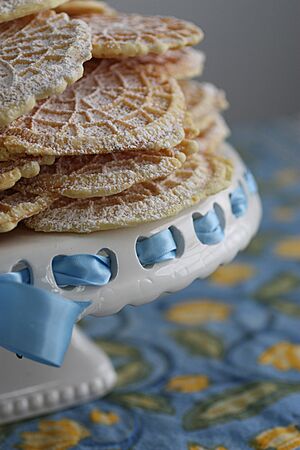
Abruzzo's sweets are well-known:
- Dragée (also known as confetti): sugar-coated almonds from Sulmona
- Torrone Nurzia: chocolate nougat from L'Aquila
- Parrozzo: a cake-like treat made from crushed almonds and coated in chocolate
- Pizzelle (also known as ferratelle): a waffle cookie, often flavored with anise
- Croccante, a type of nougat made from almonds and caramelized sugar, often flavored with lemon
- Calgionetti, cagionetti, caggiunitti, caviciunette: Christmas fritters, sometimes filled with chestnuts or chickpeas and flavored with chocolate or cocoa
- Bocconotti: stuffed sweets often served for Christmas
- Zeppole di San Giuseppe: fried or baked pastries made for Saint Joseph's Day
- Sise delle monache [it], two layers of sponge cake filled with custard, produced in the town of Guardiagrele in the province of Chieti
Fruits
The region's principal fruits are:
- Agrumi della costa dei trabocchi: coastal citrus (particularly oranges), used for jam and Limoncello
- Castagna roscetta della Valle Roveto and Marrone di Valle Castellana: types of chestnut
- Ciliege di Raiano e di Giuliano Teatino: a local cherry
- Mandorle di Navelli: almonds from the town of Navelli
- Mela della Valle Giovenco: apples from the region
- Uva di Tollo e Ortona: table grapes, also used for jam
Olive oil
The use of oil in regional mountain and sea dishes is important; among the most common oil products are the Aprutino Pescarese, the Pretuziano delle Colline Teramane, l'Olio extra vergine di oliva delle Valli Aquilane and Colline Teatine.
The list of Abruzzo olive cultivars:
- Castiglionese
- Dritta
- Gentile di Chieti
- Intosso
- Monicella
- Carpinetana
- Morella
- Nebbio di Chieti
- Raja
- Toccolana
- Tortiglione
- Crognalegna
- Gentile del L'Aquila (Rusticana del L'Aquila)
The extra-virgin olive oil produced in Colline Teramane (Teramo hills) is marked by the DOP.
The region has several cultivars that includes Carboncella, Dritta (Dritta Francavillese and Dritta di Moscufo), Gentile del Chieti, Nostrana (Nostrana di Brisighella), and Sargano olive cultivars.
Wines and liquors
Renowned wines like Montepulciano DOCG, Trebbiano d'Abruzzo DOC and Controguerra DOC are judged to be amongst the world's finest. In 2012, a bottle of Trebbiano d'Abruzzo ranked No. 1 in the top 50 Italian wine awards.
In recent decades these wines have been joined, particularly, by wines from lesser known (heritage) white grapes, such as, Pecorino, Cococciola, Passerina, Montonico bianco and Fiano.
IGT wines are Alto Tirino, Colli Aprutini, Colli del Sangro, Colline Frentane, Colline Pescaresi, Colline Teatine, Del Vastese (or Histonium), Terre di Chieti, and Valle Peligna. The region is also well known for the production of liqueurs such as Centerbe, Limoncello, Ratafia and Genziana.
Gallery
-
Ponte sul mare in Pescara
-
Duomo of Teramo
-
L'Aquila 99 Spouts Fountain
-
San Bernardino Basilica in L'Aquila
-
Palazzo Savini in Teramo
See also
 In Spanish: Abruzos para niños
In Spanish: Abruzos para niños




